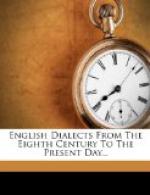1. Shetland and Orkney. 2. Caithness. 3. Nairn, Elgin, Banff, Aberdeen. 4. E. Forfar, Kincardine. 5. W. Forfar, most of Perth, parts of Fife and Stirling. 6. S. Ayr, W. Dumfries, Kirkcudbright, Wigton. 7. S.E. Argyle, N. Ayr, Renfrew, Lanark. 8. Kinross, Clackmannan, Linlithgow, Edinburgh, Haddington, Berwick, Peebles. 9. E. Dumfries, Selkirk, Roxburgh.
II. Ireland.—Ulster, Dublin, Wexford.
III. England and Wales, in five divisions: (a) Northern; (b) Midland; (c) Eastern; (d) Western; (e) Southern.
(a) Three groups: 1. Northumberland, N. Durham. 2. S. Durham; most of Cumberland, Westmoreland, N. Lancashire, hilly parts of W. Riding of Yorkshire. 3. N. and E. Ridings of Yorkshire.
(b) Ten groups: 1. Lincolnshire. 2. S.E. Lancashire, N.E. Cheshire, N.W. Derby. 3. S.W. Lancashire, S. of the Ribble. 4. Mid Lancashire, Isle of Man. 5. S. Yorkshire; to the S.W. of the Wharfe. 6. Most of Cheshire, N. Staffordshire. 7. Most of Derby. 8. Nottingham. 9. Flint, Denbigh. 10. E. Shropshire, S. Stafford, most of Warwickshire, S. Derby, Leicestershire.
(c) Five groups: 1. Cambridge, Rutland, N.E. Northampton. 2. Most of Essex and Hertford, Huntingdon, Bedford, Mid Northampton. 3. Norfolk and Suffolk. 4. Most of Buckingham. 5. Middlesex, S.E. Buckingham, S. Hertford, S.W. Essex.
N.B. S.W. Northampton is Southern; see (e), 4.
(d) Two groups: 1. W. and S. Shropshire (W. of Severn). 2. Hereford (except E.), Radnor, E. Brecknock.
(e) Ten groups. 1. Parts of Pembroke and Glamorgan. 2. Wiltshire, Dorset, N. and E. Somerset, most of Gloucester, S.W. Devon. 3. Most of Hampshire, Isle of Wight, most of Berkshire, S. Surrey, W. Sussex. 4. N. Gloucester, E. Hereford, Worcester, S. Warwick, N. Oxford, S.W. Northampton. 5. Most of Oxford. 6. N. Surrey, N.W. Kent. 7. Most of Kent, E. Sussex. 8. W. Somerset, N.E. Devon. 9. Most of Devon, E. Cornwall. 10. W. Cornwall.
CHAPTER XII
A FEW SPECIMENS
There is a great wealth of modern dialect literature, as indicated by the lists in the E.D.D. Some of these dialect books are poor and inaccurate, and they are frequently spelt according to no intelligible phonetic principles. Yet it not unfrequently happens, as in the works of Sir Walter Scott and Charles Dickens, that the dialectal scraps indicate the pronunciation with tolerable fidelity, which is more than can be said of such portions of their works as are given in the normal spelling. It is curious to notice that writers in dialect are usually, from a phonetic point of view, more careful and consistent in their modes of indicating sounds than are the rest of us. Sometimes their spelling is, accordingly, very good. Those who are interested in this subject may follow up this hint with advantage.




